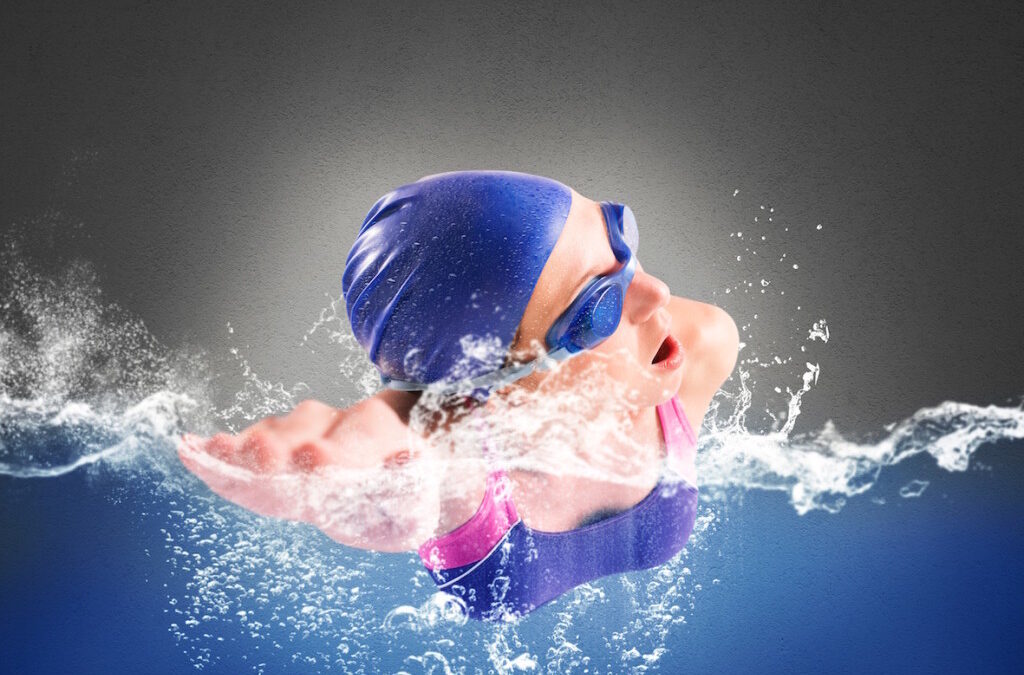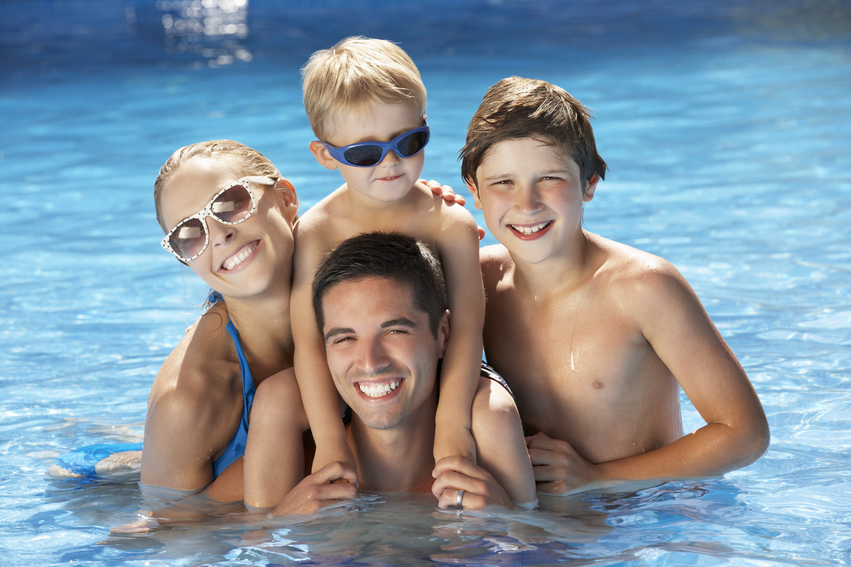It’s summer, and you’re motivated to make an extra effort to exercise—just as it’s getting too hot to spend any amount of time outside. But if you’re not a gym member or a “gym type,” what’s your salvation? The answer: a swimming pool workout.
Why Water Works?
No other workout burns calories, boosts metabolism and firms every muscle in your body (without putting stress on your joints) better than a workout with pool exercise. Because water is nearly 800 times denser than air, each kick, push, and pull is like a mini resistance workout for your entire body—especially your core, hips, arms, shoulders and glutes. It’s this equation that helps you build lean muscle, which ignites your metabolism so that you burn more calories once you’ve showered and dried off.
According to calculations from the Mayo Clinic, the calorie-burning properties of water exercise are great at any starting weight:
| 160 lbs. weight | 200 lbs. weight | 240 lbs. weight | |
|---|---|---|---|
| Water aerobics | 402 calories burned | 501 calories burned | 600 calories burned |
| Light to moderate lap swimming | 423 calories burned | 528 calories burned | 632 calories burned |
| Vigorous lap swimming | 715 calories burned | 892 calories burned | 1,068 calories burned |
If you’re unable to swim laps, or recovering from injuries that make swimming difficult, hop into the pool for some alternative exercise that benefits you just as well. It’s great exercise for the kids too, and something you can do together as a family.
Pool Running
A deceptively simple form of exercise, pool running comes with a multitude of benefits:
- It’s zero impact.
- You virtually can’t get hurt.
- It’s one of the best alternative exercises for injured runners and a perfect exercise for anyone looking to stay cooler in these hot summer temperatures.
- You don’t even need goggles to do it.
Proper form is what makes this workout a success. Just like running on land, you need to keep your back straight and pump your arms the same way, maintaining about a 90-degree angle at your elbow. Beware of running too slowly—slower strides will make your legs overextend in the water. See if you can sustain a quick turnover of 160-180 strides per minute.
It’s also important to keep your heart rate up, or else you’re not maintaining your fitness levels. Running in the pool, with no wind resistance or impact, you can be fooled into thinking you’re working harder than you think you are.
Aqua Fitness
For a fun and social way to get in shape, check out an aqua fitness class. The exercises go easy on your joints, but do wonders for muscle development, heart health and calorie burning. Many classes offer resistance equipment such as noodles, barbells and boards, water shoes and even gloves to help up the ante—and the results.
Classes are offered at fitness centers like Life Time Fitness, the YMCA and The Triangle Aquatic Center (TAC). Drop-ins are usually welcome, so for a nominal fee you can try out the class first without committing to a series. Schedules are flexible—so whether you’re a morning exerciser or someone who prefers a workout after the workday, you can find a schedule that suits your needs.
Water Therapy for Back Pain
A little water resistance can also work wonders for anyone suffering from mild to chronic back pain, including sciatica and back pain related to pregnancy. Here are some pool exercises to try:
-
Knee-to-Chest Exercise
This exercise strengthens and stretches the muscles in the leg, hip, and lower back.
To perform this exercise, begin with your back to the side of the pool and your hands holding onto the sides. Then, stand on one (slightly bent) leg, and keep your other leg stretched out in front. Slowly bend your outstretched leg towards your chest, and hold it there before returning it to its original outstretched position. Continue this for three sets of ten, pausing between sets.
-
Leg Raise Exercise
This exercise strengthens and stretches the muscles in the leg, hip, and lower back.
To perform this exercise, remain with your back to the side of the pool and your hands holding onto the sides. Then, stand on one (slightly bent) leg, and raise your other leg straight up from the ground, extending it out in front. Slowly bend your outstretched leg towards your chest, and hold it there before returning it to its original outstretched position. Continue this for three sets of ten, pausing between sets.
-
Wall-Facing Leg Stretch Exercise
This exercise extends all regions of the back and the joints in the back, as well as stretching shoulder muscles.
To perform this exercise, assume a “Superman” position with hands resting on the side of the pool and the body and legs outstretched into and supported by water. Extend your legs as far as they can, for as long as you can, before dropping your legs to the pool floor for a moment of support. Continue this for three sets of five.
Where to Swim
In Durham, you can go to Levin JCC for your pool exercise workout. We are partnering with them, and have guest day passes and their class schedule available at LifeStyle Medical Center. Other places to swim in the surrounding area are:
Durham Parks and Recreation:
Operates two indoor, eight-lane pools offering a number of water programs including exercise/fitness, swim lessons, swim teams, lap swim and family swim. Daily fees for outdoor pools range from $3 for resident adults to $5 for nonresidents, with those over 55 paying a dollar less.
Edison Johnson Aquatics Center has a portable aquatic lift to assist patrons who may not have the ability to access the pool via vertical ladders and stair systems. They also maintain outdoor seasonal pools across the city.
The City of Raleigh:
Has four year-round facilities (Buffaloe Road, Millbrook Exchange, Optimist and Pullen) and five seasonal pools. Daily fees range from $7 for resident adults to $14 for nonresidents, with those over the age of 55 paying a few dollars less.
Purchase punch passes, and you can use them for 15 entries at all City of Raleigh Aquatic Facilities. Punch passes expire 1 year from the date of purchase.
Check out the pools closest to you and see which have the features you’re looking for – current channels, water vortexes, water basketball and volleyball, water fitness classes and lap lanes. You can also find dedicated lap swim times for each pool. For example, Millbrook dedicates almost half its Olympic-sized pool to lap swimming.
The Town of Chapel Hill:
Operates two indoor pools—the Community Center pool and the Homestead Aquatic Center—offering lap swims, swim classes, deep water and aquatic exercise classes as well as movement programs.
Daily fees are $4 for resident adults and for $7 for nonresident adults.
You can purchase a 20-visit pass, 6-month pass or an Annual Pass, as well as a Family Pass Package.
Life Time Fitness:
At 8515 Falls of Neuse Road in Raleigh features a 5-lane, 25-meter indoor lap pool, outdoor swimming pool and whirlpools. You can swim laps, take aqua fitness and swim lessons, compete on the swim team or even train for an event by improving your stroke and endurance in a Masters class.
YMCA:
Has locations across the Triangle featuring both indoor and outdoor pools.
The Triangle Aquatic Center (TAC):
This is the largest public aquatic facility in North Carolina. Conveniently located off Interstate 40 near the Cary Towne Center, it features three pools (a 50-meter competition pool, 25-yard program pool and an instructional pool) and is fully handicapped-accessible. Adult swim classes, fitness classes and competitive swim programs are all available.
Exercise doesn’t have to be boring, and water work is a fun way to contribute to managing your weight.


